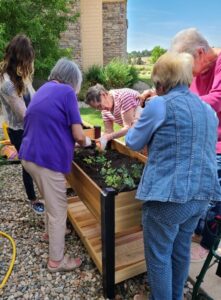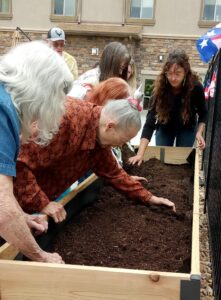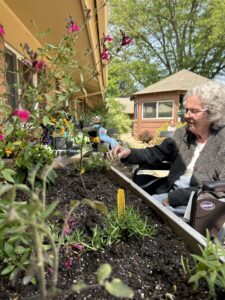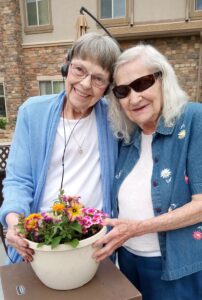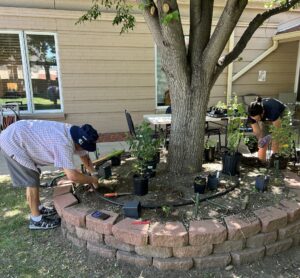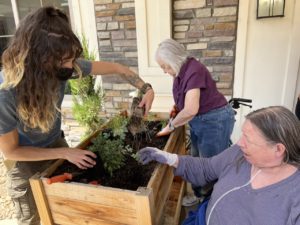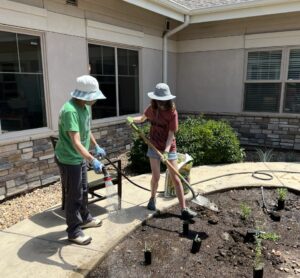Butterfly Pavilion Healthy Habitats Gardening Program
Since its inception in 2002, each spring the Healthy Habitats Gardening Program has provided social, cognitive, psychological, and physical benefits to older adults at memory care, skilled nursing, and rehabilitation facilities across the Denver metro area. The program’s goal is to provide a home for Colorado butterflies and other wildlife while facilitating a connection to nature, continued education, and a route to physical and mental health for older adults.
Engaging Horticulture Therapy
Over the course of a year, participants at selected facilities learn about habitat gardening, engage in horticulture therapy, and enjoy the butterflies and blooms. These gardens provide important food and shelter for pollinators of Colorado, where rapid development threatens populations and their habitats.
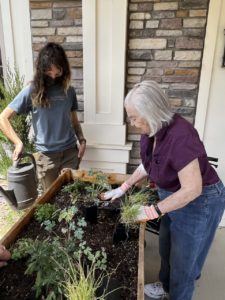
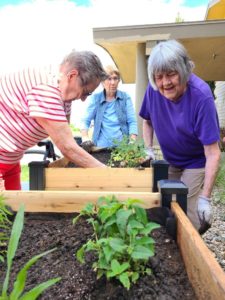
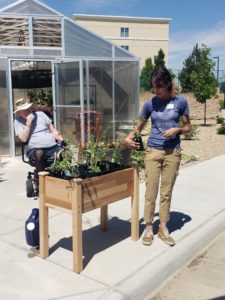
Healthy Habitats Gardening Program
Since 2002, the Healthy Habitats Gardening program has provided this experience to over 3000 individuals at over 70 different facilities in the Denver metro area. Over the course of a year, participants learn about habitat gardening, engage in horticulture therapy, and enjoy the activity of pollinators visiting flowers. Participants receive social benefits from interacting with one another and with the program volunteers. These gardens also provide habitat for native butterflies along the Front Range of Colorado, where rapid development has caused populations to decline. This program, which was recognized with the Citizen/Community Award from Colorado Alliance of Environmental Education in 2010, has continued to draw interest from centers throughout the Denver metro area.
Between 2-10 facilities are selected each year, based on resident interest, financial need, and site availability. Butterfly Pavilion educators present a fun and informational talk about pollinators and gardens to each facility in the spring, , then horticulture staff and volunteers come to the facility in the summer to plant native perennials that attract pollinators. These garden programs and habitat gardens may reach dozens of residents at each site, and the gardens remain part of the facility for as long as the community desires.
Applications for this program are sent to local facilities in February, and centers are chosen based on the following factors: level of interest and need for enrichment for the residents, accessibility, sun exposure, irrigation availability and soil type. Once the sites are chosen in early spring, a representative from the Butterfly Pavilion Program and Exhibit branch teaches the older adults about the fundamentals of pollinator gardening and the biology of native pollinator species. The horticulture director designs the garden, selecting native plants that provide resources for pollinators but are also easy to care for and appealing to the senses. In early summer, Butterfly Pavilion staff and volunteers bring tools, gloves and plants in order to install the new garden. During installation, residents help to plant and water the garden, and they are encouraged to offer opinions, tell stories and learn more about the plants and pollinators. Tasks are organized and tools are provided so that even the frailest member of the community can participate if they wish.
Once the garden is planted, Butterfly Pavilion horticulturists are available for consultation at any time, and each facility receives a “Care Packet” with pollinator gardening resources and other ideas about using the new garden in a variety of programs for the residents. Butterfly Pavilion staff and volunteers visit each facility throughout the summer and fall to put on workshops, to bring a butterfly kit, and check on the success of the garden and the engagement of the residents. Residents get to raise painted lady butterflies to adulthood, so that they can release them in the garden. At the end of the year, Butterfly Pavilion sends out evaluations to rate the satisfaction of the community with the program. By the following spring, the community is encouraged to report on the overwintering survival of the garden perennials.
In speaking to the activity directors of participating facilities, the Butterfly Pavilion has been thrilled to learn that older adults are more active, that they enjoy visits from butterflies, they noticed more about the natural world. All evaluations noted that residents spent more time outdoors after the program. One activity director from the 2008 program recalled, “Never before have the older adults spent so much time in the courtyard. Residents who were opposed to fresh air and sunshine went outside.” Another director from that year mentioned, “The older adults love not only the butterflies, but the beautiful flowers as well.” Another older adult center reported, “It was like a daily gift for our residents, especially those with memory problems.”
Healthy Habitats Gardening Program is made possible by a grant from Colorado Gives Foundation.
Following are the selected communities since 2022:
Crossroads Memory Care in Lakewood
Good Samaritan at Fox Run in Greeley
The Lodge at Greeley
The Peaks at Old Laramie Trail in Lafayette
The Rose House in Louisville
Balfour at Lavender Farms in Louisville
Prestige Care Center of Morrison
Valley View Villa of Fort Morgan
Bethesda Gardens in Loveland
The Argyle of Denver



